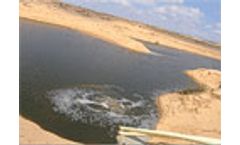Canal Irrigation Articles & Analysis
17 articles found
HDPE canal liner has been estimated that irrigation canals experience water loss of 30-40%, with seepage being one of the main factors causing water loss. ...
The United Irrigation District (UID) in Southern Alberta, Canada serves 34,400 acres of rural land through a series of canals, channels and pipelines running 236 km throughout the region. ...
Our study area in the People's Victory Canal Irrigation District of Henan Province in China has been transferring agricultural water to the city for municipal use. This study starts with an examination of the impacts of irrigation frequency, irrigation water sources, and irrigation water supply performance on ...
The difficulty of managing a canal is partly caused by the lack of knowledge of the canal state because the scheduled demand is often not fulfilled, since farmers extract more water than is scheduled and it is impossible for the watermaster to determine the canal state. ...
It was found that the water-use security status of farmers was highly influenced by the irrigation scheme in which they were operating. Across the schemes, farmers in the head-end of the irrigation canal were more water-use secure than those in the tail-end. ...
Actually, the Palmeral is a historic irrigation system with rows of palm trees flanking rectangular fields and serving as a windbreak and shade for the cultivation of wheat, alfalfa, fruit trees and vegetables. This system and its cultivation methods were mainly developed during the Islamic period and maintained after the Christian Reconquista in 1265 until recently. The main ...
Project Background “Different materials to protect canal liners had been tried in irrigation canals across the West over the past 15 or 20 years. ...
Our study area in the People's Victory Canal Irrigation District (PVCID), which is downstream of the Yellow River in China, has been undergoing agricultural water transfer to the city for municipal uses. ...
Considerable amounts of water can be saved by automating irrigation canals. The design of most of the practical automatic controllers rely on a simplified model of the irrigation canal. ...
A tamper is perfect for compressing small irrigation canals and trenches, performing landscaping compaction or preparing soil for laying stones to make walkways. ...
The literature on the dynamics of irrigation management, in terms of the analysis of interlinked agrarian relations, is very limited. ...
Surveys of relic canals at the Oasis of Otrar in Kazakhstan have been used to re-construct patterns of agricultural water use for irrigation between AD700 and AD1500. Hydraulic simulation software was used to calculate the water carrying capacity of historical irrigation canal networks. An analysis of modern day ...
This means we are meeting current demands in part by consuming the earth’s natural assets, setting the stage for an eventual Ponzi-type collapse when these assets are depleted.As of mid-2009, nearly all the world’s major aquifers were being overpumped. We have more irrigation water than before the overpumping began, in true Ponzi fashion. ...
Since it takes 1,000 tons of water to produce 1 ton of grain, it is not surprising that 70 percent of world water use is devoted to irrigation. Thus, raising irrigation efficiency is central to raising water productivity overall.In surface water projects—that is, dams that deliver water to farmers through a network of canals—crop usage of ...
Scores of countries are overpumping aquifers as they struggle to satisfy their growing water needs. The drilling of millions of irrigation wells has pushed water withdrawals beyond recharge rates, in effect leading to groundwater mining. ...
This paper discusses the implementation of irrigation reform policy in the State of Andhra Pradesh, India. It reports on the impact of the introduction of participatory irrigation management (PIM) in two secondary canals (distributaries) in the Tungabhadra Right Bank Low Level Canal irrigation system. The ...
Maintenance of irrigation infrastructure is essential to sustain food production and farmers' earnings. ...








